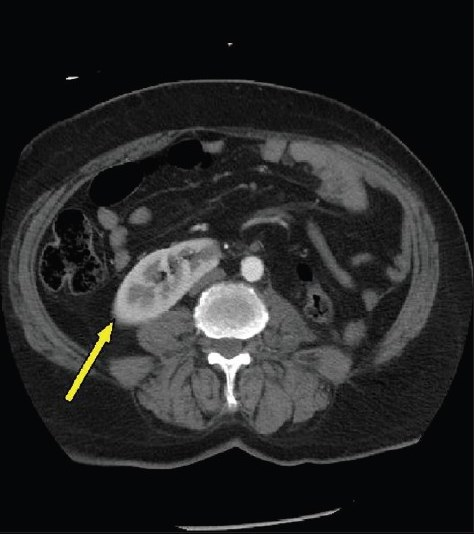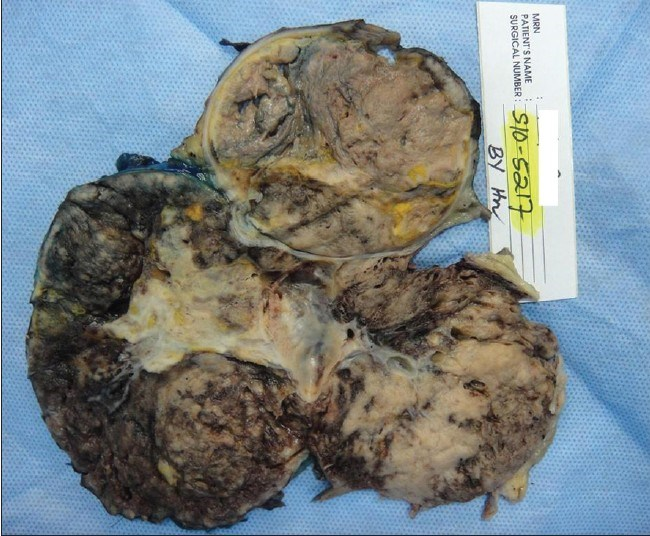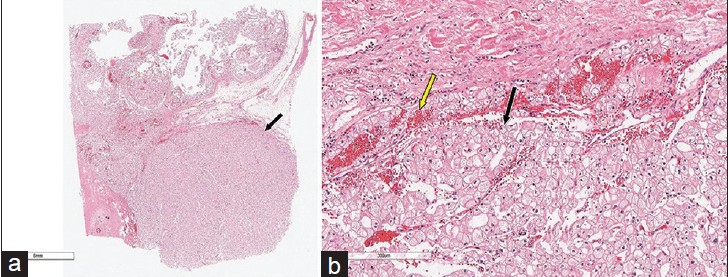Translate this page into:
Renal Cell Carcinoma in a Horseshoe Kidney: Radiology and Pathology Correlation
Address for correspondence: Dr. Ali Alamer, Department of Medical Imaging, King Abdul Aziz Medical City for National Guard, Riyadh 11426, P.O. 22490, Saudi Arabia. E-mail: ali3meer@hotmail.com
-
Received: ,
Accepted: ,
This is an open-access article distributed under the terms of the Creative Commons Attribution License, which permits unrestricted use, distribution, and reproduction in any medium, provided the original author and source are credited.
This article was originally published by Medknow Publications & Media Pvt Ltd and was migrated to Scientific Scholar after the change of Publisher.
Abstract
Renal cell carcinoma (RCC) is encountered in about 3% of all adult neoplasms. Presence of any kidney malformation can change the plan for surgical treatment of RCC with organ preserving surgery. We report a case of clear cell RCC in a horseshoe kidney. Computed tomography scan revealed a horseshoe kidney anomaly with a large mass in the left side. The diagnosis of RCC was confirmed by pathology and histology findings.
Keywords
Horseshoe kidney
radiology and pathology correlation
renal cell carcinoma
INTRODUCTION

Horseshoe kidney is the most common renal fusion anomaly. Patients are often asymptomatic and the anomaly is discovered during imaging studies carried out for other reasons. However, when symptoms are present, they are related to hydro-nephrosis, infection, or calculus formation. The incidence of renal tumor in a horseshoe kidney is higher than in normal population. We present a case of renal cell carcinoma (RCC) in a horseshoe kidney. Only rarely is RCC encountered in a horseshoe kidney. Presence of the kidney malformation can change the surgery plan for preserving the organ without removing any functional tissue.
RADIOLOGICAL FEATURES
A 62-year-old male patient presented to our institute, as a referral case from another hospital, with an abdominal mass. Computed tomography (CT) scan of abdomen and pelvis was performed utilizing routine CT renal mass protocol. The scan revealed presence of a horseshoe kidney anomaly with a well-enhanced isthmus [Figure 1a]. By using a power injector, we administered 150 mL of intravenous contrast material at a minimum rate of 3 mL/s. Using, a multi-detector row CT scanner, contrast material-enhanced imaging was performed during the corticomedullary and nephrographic phases of enhancement using scanning delays of 40 s and 100 s, respectively. Large lobulated mass was identified in the left side of the horseshoe kidney associated with an area of central cystic necrosis. The mass measured about 12 cm × 13 cm × 15 cm in anterior-posterior, width, and crainio-caudal maximum dimensions, respectively [Figure 1b and c]. The renal vein and intravenous vena cava were patent and there was no evidence of significant enlarged intra-abdominal lymph nodes. No distant metastasis was detected. The diagnosis made was RCC with a horseshoe kidney and patient was sent for urology consultation and surgical resection.

- (a-c) CT scan images of the abdomen obtained at the level of inferior mesenteric artery. (a) Before administration of the contrast material shows a horseshoe kidney anomaly (arrow). Post-contrast images in b) axial and c) coronal planes show a large mass arising from the left part of the horseshoe kidney (arrow). The mass is multi-lobulated and heterogeneous in attenuation with a central area of cystic necrosis
Hemi-nephrectomy was performed at our institute. Follow-up CT scan of the abdomen and pelvis obtained in the post-operative period revealed resection of the previously described large mass within the left part of the horseshoe kidney. No residual tumor or recurrence was seen. The right part of the horseshoe kidney was unremarkable [Figure 2].

- Single selected axial computed tomography scan image of the abdomen performed in the post-operative period shows resection of the large mass in the left part of the horseshoe kidney with organ preserving surgery. The right part is grossly unremarkable (arrow).
PATHOLOGICAL FEATURES
The surgically removed gross specimen was a large mass, which had replaced more than 2/3 of the left side of the horseshoe kidney. The mass was lobulated and variegated, ranging from tan and yellow to dark brown. It showed scattered hemorrhagic and necrotic areas [Figure 3]. No gross tumor infiltration was identified in the adjoining kidney.

- Pathology specimen shows a large multi-lobulated mass associated with an area of hemorrhage and cystic necrosis.
Hematoxylin-Eosin (H and E) stained histology slides of the above described mass revealed clear cell RCC with prominent borders and profuse network of small, thin-walled sinusoid-like blood vessels [Figure 4a and b]. The mass was graded as Grade 2 using Fuhrman nuclear grading system. No capsular invasion was seen. The diagnosis was made to be conventional type, clear cell RCC.

- Hematoxylin and eosin stained slides of the clear cell renal cell carcinoma (RCC) mass in a horseshoe kidney. (a) At ×6 magnification shows the tumor margin (arrow) in relation to the reminder of the kidney, (b) At ×300 shows clear cells with prominent cell borders (black arrow) and vascularity (yellow arrow)
DISCUSSION
Horseshoe kidney is the most common type of renal fusion anomaly. Horseshoe kidney occurs in 1 per 400-600 live births.[1] The true incidence probably lies somewhere between these two extremes. However, the reported incidence in the literature is about 0.25%.[2] Horseshoe kidney is twice as common in males as in females.[1] No genetic determinant is known, although, it has been reported in identical twins and in siblings within the same family.[1] Horseshoe kidney consists of two distinct functioning kidneys on each side of the mid-line, connected at the lower poles by an isthmus of functioning renal parenchyma or fibrous tissue that crosses the mid-line of the body.
Nearly, one-third of all patients with a horseshoe kidney remain asymptomatic and the pathology is discovered incidentally during physical examination or CT and ultrasound scans.[3] When symptoms are present, they are related to hydro-nephrosis, infection, or calculus formation. The incidence of renal tumor in a horseshoe kidney is approximately 3 to 4 times greater than in normal population, and is possibly the result of chronic obstruction, lithiasis, and infection.[3] RCC is the most common neoplasm associated with horseshoe kidney. The tumor can localized at any part of the kidney but it mostly found within the isthmus.[4]
CT utilizing routine renal mass protocol is the primary imaging modality of choice for localization and staging of any renal tumor. However, in case of RCC and horseshoe kidney, CT angiography is highly recommended to check the renal vascularity, which generally varies and is essential for pre-operative planning. If CT scanning is performed specifically to evaluate a known renal mass, the study must include an unenhanced examination prior to the administration of intravenous contrast material. After administration of contrast, scans are taken at intervals of 40 s and 100 s during the enhancement phase.[5] The dataset can be manipulated by using a 3D workstation to produce volume-rendered and 3D images when necessary. It is becoming increasingly important for radiologists to produce 3D reconstructed images as more laparoscopic surgery is being performed for the treatment of renal cancer, and these images are helpful in such procedures.
The surgical resection is considered the best therapeutic option in case of resectable disease. Thus, pre-operative surveillance is highly recommended for early identification of metastatic activity and positive surgical margin. Surgical approach is through the mid-line in order to have better exposure of the isthmus for isthmectomy.[4]
Clear cell RCC, the pathology subtype, as found in our case, is typically a solitary tumor and the tumor commonly presents as bosselated, well-circumscribed mass with fibrosis and with a capsule or pseudo-capsule. Cystic degeneration is often seen.[6] Lipid-rich cells in clear RCC impart the classical golden yellow color seen on gross pathology analysis. Clear cell RCC appears heterogeneous with areas of necrosis and hemorrhage. Clear cell RCC may exhibit a variety of histo-architectural patterns including, solid, alveolar, and acinar forms.[7]
CONCLUSION
Horseshoe kidney is the most common renal fusion anomaly and is more predominate in males and it is detected mostly as incidental finding on CT or US examination. RCC is one of the malignancies associated with this malformation, as was seen in our case.
Available FREE in open access from: http://www.clinicalimagingscience.org/text.asp?2013/3/1/12/109725
Source of Support: Nil
Conflict of Interest: None declared.
REFERENCES
- Determining the incidence of horseshoe kidney from radiographic data at a single institution. J Urol. 2003;170:1722-6.
- [Google Scholar]
- Papillary renal cell carcinoma in the horseshoe kidney. South Med J. 2010;103:1272-4.
- [Google Scholar]
- Clear cell carcinoma in horseshoe kidney: A case report and literature review. Rev Mex Urol. 2010;70:111-5.
- [Google Scholar]
- Common and uncommon histology subtypes of renal cell carcinoma: Imaging spectrum and pathological correlation. Radiographics. 2006;26:1795-806.
- [Google Scholar]






